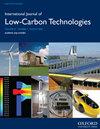优化建筑表面反射率,减少封闭式教学楼的能源负荷和二氧化碳排放
IF 2.3
4区 工程技术
Q3 ENERGY & FUELS
引用次数: 0
摘要
建筑物表面反射率决定了反射太阳辐射量,它间接影响建筑物的冷热负荷。因此,优化建筑表面反反射率是降低建筑能量负荷和CO2排放的有效方法。为了分析建筑表面反射率的优化潜力,基于Energyplus软件,模拟了建筑表面反射率对日、月、年能源负荷以及CO2排放的影响。数值结果表明,在4个典型季节日能量负荷中,1月、4月和10月日能量负荷与建筑表面反射率呈正相关,7月为负相关。月度能源负荷中,1月和8月建筑冷热负荷最高;对于年能量负荷,反射率越高,冷负荷越低,热负荷越高。当建筑表面反射率为0.7时,年能量负荷最小,为148.23 kWh/m2。此外,CO2排放量也最低,为24.79 kg/m2。根据建筑表面反射率与后向反射率的关系,最佳后向反射率为0.47。本文章由计算机程序翻译,如有差异,请以英文原文为准。
Optimizing building surface retro-reflectivity to reduce energy load and CO2 emissions of an enclosed teaching building
Building surface reflectivity determines the amount of reflected solar radiation, which indirectly affects the cooling and heating load of a building. Therefore, optimizing building surface retro-reflectivity is an effective method to reduce energy load and CO2 emissions of buildings. To analyse the optimization potential of building surface retro-reflectivity, the effect of surface reflectivity on daily, monthly and yearly energy load, as well as CO2 emissions of an educational building were simulated based on the Energyplus software. The numerical results showed that for daily energy load in four typical seasons, there was a positive correlation between the daily energy load and building surface reflectivities in January, April and October and a negative correlation in July. For monthly energy load, the building cooling and heating loads were the highest in January and August, respectively. For annual energy load, the higher the reflectivity, the lower the cooling load and the higher the heating load. When the building surface reflectivity was 0.7, the annual energy load was the least, with a value of 148.23 kWh/m2. In addition, the CO2 emission was also the lowest, with a value of 24.79 kg/m2. According to the relation between building surface reflectivities and retro-reflectivities, the optimal retro-reflectivity was 0.47.
求助全文
通过发布文献求助,成功后即可免费获取论文全文。
去求助
来源期刊

International Journal of Low-carbon Technologies
Engineering-Architecture
CiteScore
4.30
自引率
4.30%
发文量
106
审稿时长
27 weeks
期刊介绍:
The International Journal of Low-Carbon Technologies is a quarterly publication concerned with the challenge of climate change and its effects on the built environment and sustainability. The Journal publishes original, quality research papers on issues of climate change, sustainable development and the built environment related to architecture, building services engineering, civil engineering, building engineering, urban design and other disciplines. It features in-depth articles, technical notes, review papers, book reviews and special issues devoted to international conferences. The journal encourages submissions related to interdisciplinary research in the built environment. The journal is available in paper and electronic formats. All articles are peer-reviewed by leading experts in the field.
 求助内容:
求助内容: 应助结果提醒方式:
应助结果提醒方式:


